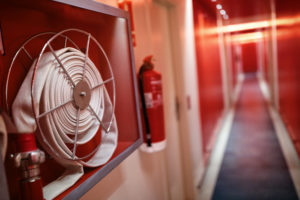
 It often takes a tragedy to highlight the need for code changes. Tragic fires have shaped our building codes, fire codes, and fire safety standards over time, to incorporate the lessons learned from historic fire events. As time passes, however, the urgency for preventing a reoccurrence is often forgotten and people become complacent about the potential for catastrophic loss of life in a building fire.
It often takes a tragedy to highlight the need for code changes. Tragic fires have shaped our building codes, fire codes, and fire safety standards over time, to incorporate the lessons learned from historic fire events. As time passes, however, the urgency for preventing a reoccurrence is often forgotten and people become complacent about the potential for catastrophic loss of life in a building fire.
As a result, we continue to learn the same lessons over and over when code requirements are not followed, when code requirements are not enforced, when an existing property is “grandfathered” out of making needed improvements, or when the occupancy of a building changes and the existing protection is not adequate for the new occupancy.
It takes everyone doing their part to avoid repeating the same mistakes and learning the same painful lessons over and over. To assure life safety from fire, we all have a role to play.
Jurisdictions must adopt appropriate building and fire codes and then actively enforce them through regular inspections. To do this effectively, the jurisdiction must provide adequate funding and staffing to complete the inspections, and then take steps to solicit prompt, corrective action by the building owner or occupant to address deficiencies uncovered during the inspections.
Architects, engineers, and other design professionals have a responsibility to comply with the code requirements adopted in the project’s jurisdiction, or satisfactorily demonstrate compliance with the code’s underlying performance objectives where appropriate. They also have a responsibility to keep their knowledge and competencies up-to-date in their field of practice, and to seek out help or guidance when there are gaps in their knowledge about a particular issue.
Contractors who install fire and life safety systems have a responsibility to confirm the systems they install follow the design documents and specifications and that the systems comply with the applicable codes and standards.
Contractors who maintain fire and life safety systems have a responsibility to confirm the systems are operating properly during their inspections and to accurately tag the systems when they are impaired.
Building owners and business operators have a responsibility to:
- Comply with the fire codes and standards to properly mark exits
- Provide emergency lighting and test it regularly
- Confirm exit doors are not blocked or locked
- Inspect, test, and maintain portable extinguishers installed in the building
- Control the amount and continuity of combustibles in the building
- Inspect, test, and maintain fire protection, detection, smoke control, and notification systems
- Test and maintain fire doors, dampers and other devices designed to cutoff the spread of fire and smoke within a structure
- To establish proper emergency evacuation procedures and train staff in these procedures and the location of all exits
- Coordinate with the local fire department to plan their response in the event of a fire
- Properly manage changes to their facility, by obtaining permits as required, and seeking help from specialists when necessary to properly manage changes within their facility
Employees have a responsibility to know the evacuation procedures and carry them out in an emergency.
Perhaps most importantly, everyone must take some personal responsibility for their own safety, whether in their own home, at work, in a restaurant, in a nightclub, in an airport, in a theater, in a stadium, or in a hotel, etc.
Understand that some existing buildings may not meet the current life safety standards because they have been grandfathered out of the modern requirements.
Think about the list above, and all the people who have a role in making sure building occupants are safe from the effects of fire. Considering the human factor, there is a lot of opportunity for something to be missed or to go wrong in the process.
That is why each person must be very attentive to conditions in the buildings they access. Pay attention and look around when you enter a building:
- Do the doors swing in or out?
- Is the entry through a revolving door?
- Is there a swinging door near any revolving door?
- Where are the other exits?
- Is the building sprinklered?
- Does it have a fire alarm system?
- Is the place over-crowded?
- Is there a significant amount of combustibles present?
- Are there special hazards present that increase the potential for a fire?
When a fire alarm goes off, don’t be the person sitting there waiting to see if there is really a fire. Take advantage of the notification provided by a fire alarm system and immediately evacuate until you can confirm or rule out a fire condition.
Be aware of the conditions around you and take personal responsibility for your own safety and for the safety of those you love. Ask questions, and leave, if you don’t feel comfortable with the situation.
We hope you have enjoyed and learned something of value to you from this five-part blog series on historic fires that have shaped our building codes, fire codes, and standards. We sincerely hope you have a better appreciation of your role in making sure buildings occupants are safe from the effects of fire.

